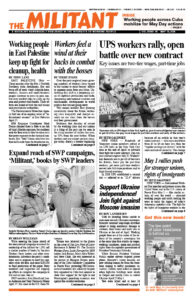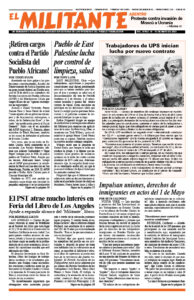Over the past couple of years growing numbers of workers have turned to our unions to resist bosses’ efforts to squeeze more from our labor. Underlying this shift is a deepening crisis of capitalist production and trade, sharpening international rivalries and rearmament, developments in world politics that are not going away.
This means workers face growing uncertainty about the future, widening class inequality and sharper assaults on our class from the bosses and their government.
Evidence that decades of retreat by the working class and our unions is a thing of the past can be seen in the rising number of strikes last year, up 50% from the year before. When workers and our unions go into struggle today, there’s a breeze beginning to blow behind our backs.
What’s changing in the outlook of working people is also evident in the response Socialist Workers Party members find to the Militant, the thirst for its coverage of today’s class battles and for discussing the working-class road forward the party advances.
This shift is noticeable worldwide, from strikes by public sector workers in Canada and nurses in the U.K., to the battle being waged by Ukrainian workers and farmers to drive Moscow’s invading forces from their soil, to struggles by workers and the oppressed in Iran against the diktats of its capitalist regime, and much more.
The anxiety eating at the capitalist rulers over the instability of their world system was illustrated by International Monetary Fund chief Pierre-Olivier Gourinchas April 11, when he said, “Economic growth remains low by historical standards and financial risks have risen, yet inflation has not yet decisively turned the corner.”
Manufacturing output, retail sales and house sales all fell in the U.S. in March. In the pages of the big-business press, economists are debating how big a recession is coming.
Larry Summers, treasury secretary under former President Bill Clinton, says he fears a “harder landing” is in store. He adds that it’s not a good idea to attack corporations for prioritizing profits — even price “gouging” — and it’s a bad mistake for the government to “impose various requirements that wages be high.”
What faces working people today?
Real wages today are $10 a week lower than they were when President Joseph Biden took office two years ago. For men it’s $18 a week lower. But today’s labor struggles are not driven primarily by plunging real wages but by the social and moral costs of the bosses’ onslaught.
The AFL-CIO released its annual report on job conditions April 26, saying “employers’ opposition to workers’ rights and protections has grown, and attacks on unions have intensified.” The report says that in 2021 “about 343 workers die[d] each day due to job injuries and illnesses.”
The debilitating consequences of today’s capitalist crisis is shown in the yearslong fall in the birth rate. From 2010 to 2020, birth rates dropped by 15%, with women now having an average of 1.6 children, the lowest number since 1800. This means that without immigration, the U.S. working class will shrink.
Working people from the cities to the farmstead face growing drug addiction, depression and suicide rates. These are all some of the conditions behind today’s class struggles.
Since early last year New York’s landlords have issued 146,000 eviction notices. Rents are skyrocketing and many workers are unable to pay off back debts incurred during the pandemic. Elsewhere, the center of San Francisco is getting hollowed out, with a soaring number of vacant offices as bosses cut jobs and several businesses shut down altogether.
Working farmers also feel the lash of the capitalist crisis. With interest rates for farm machinery rising to 5.86% last year and costs for fertilizer and other inputs soaring, many working farmers are foregoing purchases on machinery. The cost of paying off farm debt rose by more than 30% last year.
Looking for a way to fight back
“I don’t want roommates, I want a fair contract,” read a sign carried by a nurse at a union rally in Bend, Oregon, April 24. Years of declining real wages and today’s soaring prices make it hard for young workers to get a place of their own. Like workers elsewhere the Bend nurses are demanding bosses hire more workers to relieve intolerable workloads, “suicide schedules” and more.
The fighting spirit shown by workers, farmers and small-business people in East Palestine, Ohio, battling for health care and control over the cleanup after a Norfolk Southern train carrying toxic vinyl chloride derailed and burned there has won solidarity far and wide. It’s another sign of what’s changing. This inspires more fights by rail workers over crew size and how trains are run and struggles in other communities facing disasters bred by the capitalist “profit is everything” system.
Now more than ever, the road forward lies in the hands of the working class, our unions and its vanguard fighters. That is the perspective of the Socialist Workers Party and its sister Communist Leagues in Australia, Canada and the United Kingdom. Discussing this perspective will be at the heart of the SWP’s upcoming International Educational Conference in Oberlin, Ohio, June 8-11.
The best guide can be found in The Low Point of Labor Resistance Is Behind Us: The Socialist Workers Party Looks Forward, available from Militant distributors and from pathfinderpress.com.

